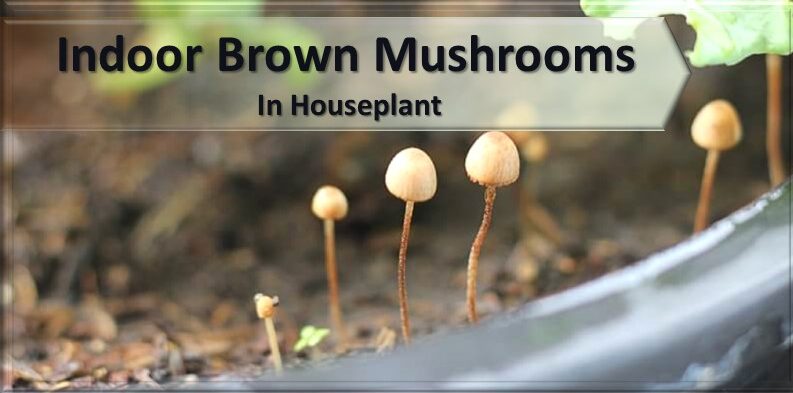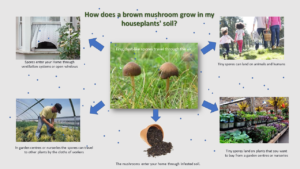If you have been shocked by seeing indoor brown mushrooms in your houseplant, they most likely are Coprinellus micaceus, Coprinopsis atramentaria, or Conocybe sp. Various types of mushrooms are common in house plants including yellow mushrooms, gray mushrooms and also brown mushrooms. Most people after seeing them say “Why?”, “How?”, “Is it dangerous?”, Join me in this article to tell you about:
- Identification of brown mushrooms growing in the soil of your houseplants.
- Can they hit your houseplant or you?
- Why are they growing in the soil of your houseplants?
- How to get rid of them?
- How to prevent them?
I know your main objective is getting rid of these annoying guests but you must note that to perform a successful treatment you have to correctly identify your invader. Hence, in the first stage, we will go to identify them.
Please note that I’m walking with you through this article. So, feel free to ask your questions by typing below this page.
First Step: What Is the Indoor Brown Mushroom in the Soil of My Houseplants?
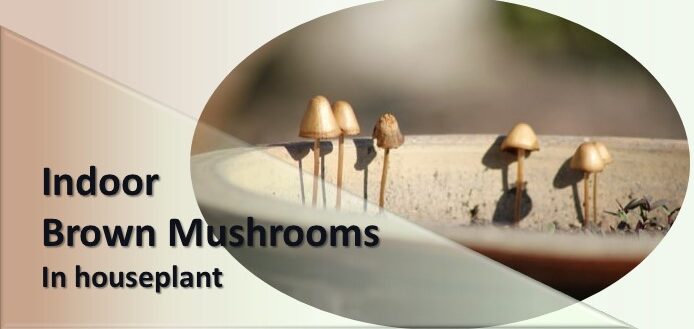
Most likely, the brown mushroom growing in potted plant belongs to:
- Coprinus genus
- Conocybe genus
It’s not off the wall to see other species of brown mushrooms in your houseplant soil, hence, the correct identification of them is necessary to know whether it is harmful or not. In addition, controlling each species has its unique management.
So, in the beginning, we try to detect them and then talk about their habits.
Identifying the Indoor Brown Mushroom Growing in Your Houseplants
Please spot the following pictures, read their characters and then try to compare your brown mushroom growing in a potted plant with it.
Coprinus Genus

- Coprinus’ colour: most of the Coprinus have a white cap and are white mushrooms growing in houseplants, but some species such as Coprinellus micaceus and Coprinopsis atramentaria have brown caps.
- The cap shape of Coprinus: Their caps may be oval, bell-shaped or convex, depending on their age. Their gills are white and then turn pink. After liquefying it will be black.
- The stem shape of Coprinus: You can see a ring on the stem. Their stem has a stipe hollow with central string fibres.
Conocybe Genus
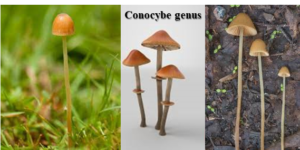
- Conocybe’s colour: It is ochre-brown to cinnamon or rust-brown.
- The cap shape of the Conocybe: First, it is conical but becomes bell-shaped.
The Habits of Indoor Brown Mushroom Growing in Your Houseplants
Now that you found out who is your new guest in your potted plant, let to know about its habits. The following information is valuable in controlling the growth of brown mushrooms in your houseplant’s soil.
Their Lifestyle:
The Indoor brown mushrooms growing in potted plants are saprophytic fungi. It means that they aren’t harmful to your houseplant. These mushrooms feed decaying matter inside the soil.
So, they can break decaying matter and convert it into tiny products that are usable for your houseplant. Hence, brown mushrooms are agents that help you to improve the growth of your indoor plant.
Their Favourite Environment:
Their favourite environment is moisture and rich soils with warm temperatures.
Rich soils have organic matter such as dead leaves, compost, mulch, wood chips or fertilizers.

Toxicity of Brown Mushrooms:
I strongly recommend avoiding eating Indoor brown mushrooms growing in your houseplant. Detecting edible mushrooms is difficult and you must have enough knowledge and experience. There are reports of the level of toxicity of brown mushrooms growing in potted plants.
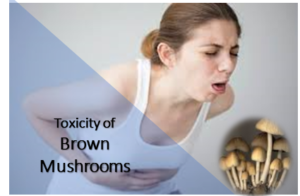
How do Brown Mushrooms Spread?
They spread with very tiny spores and mycelia. You cannot see them with the naked eye.
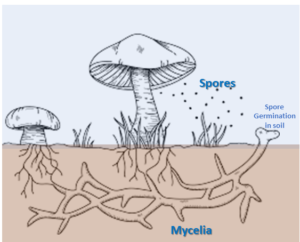
Why Is a Brown Mushroom Growing in the Soil of My Houseplants?
As mentioned earlier, the mushrooms can spread by scattering their tiny spores in the air or stalking their mycelia inside the soil. The following infographic helps you to understand how they can enter your home and grow in your houseplant soil.
- Tiny, dust-like spores travel through the air. Then, they will land in various areas.
Brown mushrooms growing in potted plants may enter your home through ventilation systems or open windows and land in your houseplant soil.
Tiny spores can land on animals and humans while they wander where there are a lot of mushrooms.
In garden centres or nurseries, it is more common for the tiny spores to land on plants that you want to buy them.
- Using infested soil: more than often, the mushrooms enter your home through infested soil.
Mushrooms grow on rich soils; hence you may collect rich but infested outdoor soil or buy infested soil with the mycelia of mushrooms. The spores of mushrooms can lie inside the soil for years until they find their favourite condition, will germinate and start to grow.
The final Step: How to Get Rid of Indoor Brown Mushrooms in my Houseplant Soil?
Now it is time to remove them. Brown mushrooms growing in potted plants are our new friends that help us to improve the quality of potting soil. In addition in some cultures growing mushrooms in houseplants is good luck. Anyway, if you have a little kid or pets and consider they eat mushrooms, you have to get rid of them.
In this part, we will talk about several ways to remove them first and then point to tips for preventing them.
First Stage: Remove Indoor Brown Mushrooms in Houseplant Soil
Getting rid of mushrooms growing in your houseplant soil is hard work. In the following infographic, you can see a chart showing the necessary factors for their growth. We use these factors to remove them.
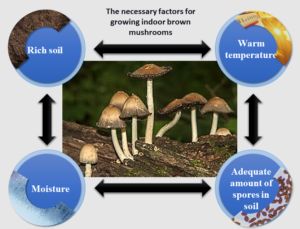
As you saw above, indoor brown mushrooms need four factors to grow in your potted plant soil:
1- Rich soil
2- Moisture
3- Warm temperature
4- Adequate number of spores in soil (inoculum)
If you can cut the above chart by removing at least one of the mentioned factors, you can prevent their growth. For example, by providing a colder environment, you can prevent their growth in your potted soil.
In the following, we first try to change the favourite growth conditions of mushrooms.
Factors 1-3 in the above list belong to its favourite conditions. Then we will effort to remove or reduce its spores and mycelia in your houseplant’s soil.
Changing Favourite Environment of Mushrooms:
Unfortunately, the best environment for mushrooms is the same as the favourite conditions of most houseplants, hence, changing it may cause a hit to your indoor plant too. So, before changing the soil quality, its moisture or the temperature, make sure about the needs of your potted plant.
Eradicating or Reducing Spores and Mycelia in Potting Soil:
- You can remove the whole soil of the potted plant (especially the soil around the roots) and replace it with uninfected soil.
Unfortunately, this way may hit your houseplant and shock it. In addition, there isn’t any guarantee that some spores may still stay in your soil.
- You can only scratch the topsoil and replace it with uninfected soil; however, its spore is still alive and will regrow but if you repeat it again and again you may see notable results.

- Physically remove the mushrooms from the soil. You can do it by cutting their caps or pulling off the mushrooms completely. It will prevent more spore production and you should perform it again and again. It may take time to see notable results. Note that put them in a plastic bag to avoid more infection.
- Using fungicides: applying chemical fungicides in the house may become as dangerous as eating brown mushrooms. However, fungicides for soilborne fungi often don’t work well. Hence, I recommend if you want to apply a fungicide, use the organic one.
- Move your plant to another place: If after performing all the best efforts, mushrooms pop up again and say hello! you should change the place of your houseplant. It is because the outdoor spores may have found a way to spread around your indoor plant.
- Remove your potting plant completely: However, it is a crazy way!
If you think you need more information about killing mushrooms in houseplants, I especially discussed it in another post.
Second Stage: Prevent Indoor Brown Mushrooms in Houseplant Soil
If you succeeded in the buttle and eradicated annoying brown mushroom growing in potted plants or you don’t have any infection but want to prevent it, keep reading to talk about preventing ways. Preventing is always easier than treating.
- Buy uninfected soils for the potting change of your houseplant.
- If you collect soil from outdoors, perform soil sterilization. Click here to show you how to sterile soil inside your home easily.
- When you want to buy a houseplant take note of the mushroom infections in other potting plants. If you see mushrooms in a garden centre or nursery, it is possible their spores were landed on other plants and travel to your house.
Conclusion
Now you found a lot of information about indoor brown mushrooms growing in your houseplant soil. you can easily answer questions such as Who are they? How to identify them? Are they dangerous for me? Can they hit my houseplant? How can they grow in my potted plant? And how to get rid of them?
If you have a question that I didn’t answer here, please feel free to ask me below or by clicking here. It is my pleasure to help you.
What is your policy about indoor brown mushrooms growing in potted plants? Do you want to remove them or do you want to leave them to do their things? Do you think the above treatments will work well? Do you have any experience with them and your unique remedies? Please share your ideas and experiences with our readers below. thank you!

Elahe Rabiei
Hi, I’m Elaheh. My Academic major is plant protection, and houseplants are my expertise. As a houseplant lover, my house is full of indoor plants and it is my passion to take care of them. Hence, I’m here to share my knowledge and experience about growing healthy houseplants. I am also a plant protection advisor, so feel free to ask me any questions you may have.

